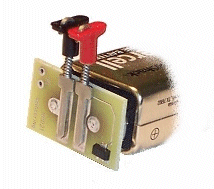Best viewed using:
Internet Explorer
or
Mozilla Firefox
Wiring our Subminiature LEDs is very easy
Having pre-tinned axial leads makes these LEDs very easy to solder. Our N5038 #38 magnet wire, or our N5030 series of #30 solid conductor wires are both excellent choices for wires these products.
If you need a flexible connection, our N5029 or N5032 multi-strand super-flexible wire will also work very well.
As noted in the section in More Info labeled Lead forming, the LED leads can be easily shaped to accommodate most applications.
For soldering, we recommend our N40M2 12-watt soldering iron and our N4200 low-temperature 2% silver electronic solder. More information about these products is available here.
Whatever the choice, one rule to remember: Always pre-tin the wire and make sure that your solder has some type of fluxing agent. This ensures that the amount of time required for your soldering to make a good joint is going to be the absolute minimum. The two easiest ways to kill an LED are: excess heat from soldering and excess voltage (or current). With good soldering practices and protection from excessive current, these LEDs will easily last 50 times as long as an incandescent bulb.
Prerequisites:
Regardless of the type of wire you're going to use there are several things that will aid in your success in working with these LEDs.
-
Good optical magnification (Optivisor, etc.)
-
Bright lighting that's position adjustable.
-
Comfortable work area with your holding fixtures elevated so you can sit upright with your arms relaxed while soldering (helps prevent the shakes and fatigue).
-
Good magnification (really important)
-
Small, low wattage soldering iron with needle tip or small chisel tip. Alternately, a temperature controlled soldering station (much more expensive but hard to beat).
-
Low-temperature wire solder with a rosin flux (not acid flux) core.
-
Good magnification (yes, I know...)
Testing your work
Whether you're planning on wiring a bunch of LEDs or just one, we cannot overemphasize the importance of testing your work before placing wired LEDs in you structures or other projects.
We carry an Intelligent LED Tester that is very inexpensive and will automatically test any 20ma LED regardless of color or pin configuration. It has a built-in state-of-the-art current source to ensure each LED receives 20ma (± 1%) current. Simply snap it onto a standard 9-volt battery and you're ready to go.






















